Thursday, October 26, 2006
October 2006 - Oktoberfest
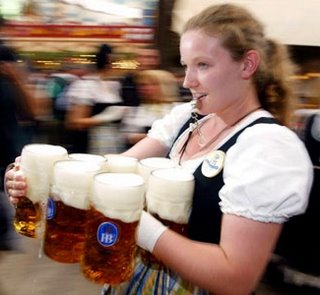
It is time again to celebrate the joys of beer, food and friends. Lot’s of US brewers are now making Oktoberfest beers, but we decided to go with traditional Germany beers we can get here in Memphis. Oktoberfest is a two-week festival held each year in Munich, Bavaria, Germany during late September and early October. It is one of the most famous events in the city and the world's largest fair, with some six million people attending every year.
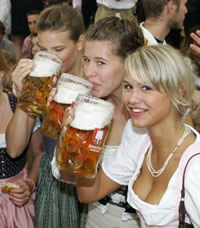
The event usually takes place during the 16 days up to and including the first Sunday in October, but if this day is the 1st or 2nd then the festival will go on until the October 3rd (German Unity Day). Thus, the festival is 17 days when the 1st Sunday is October 2nd and 18 days when it is October 1st. The festival is held on an area named the Theresienwiese (Field [or meadow] of Therese), often called “d’ Wiesn” for short. Beer plays a central role in the fair, with every festival beginning with a keg of beer tapped by the Mayor of Munich who declares “O'zapft is!” (Bavarian: “It’s tapped!”). A special Oktoberfest beer is brewed for the occasion, which is slightly darker and stronger, in both taste and alcohol. It is served in a one-liter-tankard called Maß. The first mass is served to the Bavarian Minister-President. Only local Munich breweries are allowed to serve this beer in a Bierzelt, a beer tent which is large enough for thousands.
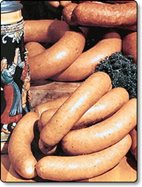 Visitors also consume large quantities of food, most of it traditional hearty fare such as sausage, hendl (chicken), käsespätzle (cheese noodles), and sauerkraut, along with such Bavarian delicacies as roast ox tails. In the year 1880, the city government approved the sale of beer. The electric light illuminated over 400 booths and tents. In 1881, booths selling bratwursts opened. In 1892, beer was first served in glass mugs. There are many problems every year with young people, who overestimate their ability to handle large amounts of alcohol. Many pass out due to drunkenness. These especially drunk patrons are often called "Bierleichen" (German for "beercorpses").The six Oktoberfest breweries, (Spaten, Augustiner, Paulaner, Hacker-Pschorr, Hofbräu, Löwenbräu) sold 6 million mugs of beer in 2005 (5.5 million in 2004).
Visitors also consume large quantities of food, most of it traditional hearty fare such as sausage, hendl (chicken), käsespätzle (cheese noodles), and sauerkraut, along with such Bavarian delicacies as roast ox tails. In the year 1880, the city government approved the sale of beer. The electric light illuminated over 400 booths and tents. In 1881, booths selling bratwursts opened. In 1892, beer was first served in glass mugs. There are many problems every year with young people, who overestimate their ability to handle large amounts of alcohol. Many pass out due to drunkenness. These especially drunk patrons are often called "Bierleichen" (German for "beercorpses").The six Oktoberfest breweries, (Spaten, Augustiner, Paulaner, Hacker-Pschorr, Hofbräu, Löwenbräu) sold 6 million mugs of beer in 2005 (5.5 million in 2004).
One of my fondest drinking memories was deciding to spend my last five dollars at the Germaina Oktoberfest on just ONE more mug of Warsteiner rather than eating a currywurst. Looking back of should of had the currywurst. Warsteiner Premium Verum is an example of a Classic German Pilsner brewed by Warsteiner Brauerei of Arnsberger Forestpark, Germany. The Warsteiner Brewery lies deep in the heart of the Arnsberger Forestpark (Arnesberg Forest Nature Park) outside of Warstein, Germany in the north central section of the country. The Cramer family has been brewing beer since 1753 with Warsteiner Premium Verum begin the #1 selling beer in Germany.
The invention of modern refrigeration by Carl von Linde removed the need for caves in which to store the beer, however even until recently the Pilsner Urquell brewery still fermented their beer using open barrels in the cellars underneath their brewery. This technology was changed in
 1993 since large cylindrical tanks are used, however small samples are still brewed in a traditional way for the comparison of the taste. They also have the unique claim to being "the world's first golden beer."
1993 since large cylindrical tanks are used, however small samples are still brewed in a traditional way for the comparison of the taste. They also have the unique claim to being "the world's first golden beer."A modern pilsener has a very light, clear color from pale to golden yellow, and a distinct hop aroma and flavor. Czech pilseners tend toward a lighter flavor with good examples being Pilsner Urquell and Staropramen, while those in a German style can be more bitter (particularly in the north, e.g. Jever) or even "earthy" in flavor. Distinctive examples of German pilseners are Flensburger, Beck's, Konig, Radeberger, Veltins, Fürstenberg and Wernesgrüner.
Next we will be drinking a beer brewed by Paulaner Brauerei brewery in Munich Germany, Paulaner Hefeweissbier. Paulaner is a German brewery, established in the early 1600s in Munich by the monks of the Neudeck ob der Au monastery. The monastic order and the brewery are named after Saint Paul.

Belgian witbieren (“white beers") are based on the best-known example, Hoegaarden Wit. Such beers get their name from the suspended wheat proteins which give it a whitish color. Belgian white beers often have spices such as coriander or bitter orange peel added, giving them a slightly fruity flavor. They are also often made with raw unmalted wheat, as opposed to the malted wheat used in other varieties.
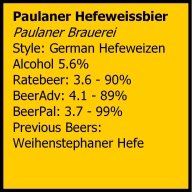
German wheat beers are a well-known variant throughout the southern part of the country, the name changing from Weizen in the western (Swabian) regions to Weißbier or Weiße in Bavaria. Hefeweizen (German for "yeast wheat") is a variety in which the yeast is not filtered out, though Kristallweizen (filtered), Dunkelweizen (dark) and Weizenbock (higher alcohol content) varieties are also available. The filtration which takes the yeast out of Kristallweizen also strips the wheat proteins which make Hefeweizen cloudy. Bavarian weizen beers are fermented with a special strain of top-fermenting yeast, Torulaspora delbrueckii, which is largely responsible for the distinctive flavor. This is the Paulaner brewery's number one best seller. It's natural taste as well as the many vitamins, minerals and micro elements remain, due to the unfiltered method of brewing.
 The next beer is Spaten Premium Lager, brewed by Spaten-Lowenbrau (InBev) in Munich, Germany. The first time the Munich tax registry lists a brewery in the building is in 1397. It was first opened by Hans Weiser and changed many times until 1522. The Stamberger family ran the brewery from 1522 to 1622 until the Spaten family purchased it in 1622. The Spaten family only ran the business for about 70 years until the Siessmayr family purchased it in 1704.
The next beer is Spaten Premium Lager, brewed by Spaten-Lowenbrau (InBev) in Munich, Germany. The first time the Munich tax registry lists a brewery in the building is in 1397. It was first opened by Hans Weiser and changed many times until 1522. The Stamberger family ran the brewery from 1522 to 1622 until the Spaten family purchased it in 1622. The Spaten family only ran the business for about 70 years until the Siessmayr family purchased it in 1704.In 1807 Gabriel Sedlmayr the Younger, the master brewer to the royal court of Bavaria at the time, purchased the smallest brewery at that time. The modern method of producing lagers was pioneered by Gabriel, who perfected the dark brown lagers that made Spaten famous. After the death of their father, Gabriel, sons Gabriel and Joseph take charge of
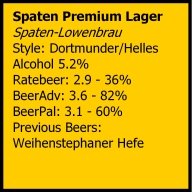 the brewery until 1842. In 1842 Joseph leaves Spaten to purchase the Leist Brewery and buys out the Franziskaner brewery in 1861.
the brewery until 1842. In 1842 Joseph leaves Spaten to purchase the Leist Brewery and buys out the Franziskaner brewery in 1861.In 1867 Spaten is now the largest brewery in Munich and is the only German brewery to receive a gold medal at the Paris World Exhibition. That is followed by creation of the first Oktoberfest beer in 1872. Johann, Carl and Anton assume control of the brewery in 1874 and work with the artist Otto Hupp to design the logo that is still used today. In 1922 The Spaten and Franziskaner-Leist breweries merge. Thus bring to gather the two Sedlmayr families.
We will be breaking away from the German beers to try a
 Spice/Herb/Vegetable beer from the Dogfish Head Brewery, Punkin Ale. Dogfish Head's signature product is its line of India Pale Ales (IPAs), which are offered in three varieties: 60 Minute, 90 Minute, and 120 Minute IPA. Their names refer to the length of the boil time of the wort in which the hops are continuously added. The 60 Minute is described by the company as "A session IPA brewed with Warrior, Amarillo and Mystery Hop X." To further enhance the hop flavor of their 90 Minute IPA and 120 Minute IPA, Dogfish Head introduced a device in 2003 jokingly called Randall the Enamel Animal, an "organoleptic hop transducer module" which "Randallizes" either Dogfish Head 90 Minute or Dogfish Head 120 Minute IPA by passing the beer through a large plastic tube filled with raw Cascade hops. The alcohol in the beer lifts oils off the raw hops and imparts even more hop flavor to beers that were already hoppy to begin with.
Spice/Herb/Vegetable beer from the Dogfish Head Brewery, Punkin Ale. Dogfish Head's signature product is its line of India Pale Ales (IPAs), which are offered in three varieties: 60 Minute, 90 Minute, and 120 Minute IPA. Their names refer to the length of the boil time of the wort in which the hops are continuously added. The 60 Minute is described by the company as "A session IPA brewed with Warrior, Amarillo and Mystery Hop X." To further enhance the hop flavor of their 90 Minute IPA and 120 Minute IPA, Dogfish Head introduced a device in 2003 jokingly called Randall the Enamel Animal, an "organoleptic hop transducer module" which "Randallizes" either Dogfish Head 90 Minute or Dogfish Head 120 Minute IPA by passing the beer through a large plastic tube filled with raw Cascade hops. The alcohol in the beer lifts oils off the raw hops and imparts even more hop flavor to beers that were already hoppy to begin with.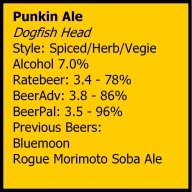 Fruits have been used as a beer adjunct or flavoring for centuries, especially with Belgian lambic styles. Cherry, raspberry, and peach are a common addition to this style of beer. Modern breweries may add only flavored extracts to the finished product, rather than actually fermenting the fruit. New Glarus Brewing Company of Wisconsin produces Raspberry Tart, a framboise made with raspberries, wheat and year old Hallertau hops, and fermented in large oak vats. Pumpkin flavored beers are brewed seasonally in the autumn in North America. An example is produced by Coors Brewing Company's Blue Moon brand. .Dogfish Head Punkin Ale is a full-bodied brown ale brewed with real pumpkin, brown sugar, allspice, cinnamon & nutmeg."
Fruits have been used as a beer adjunct or flavoring for centuries, especially with Belgian lambic styles. Cherry, raspberry, and peach are a common addition to this style of beer. Modern breweries may add only flavored extracts to the finished product, rather than actually fermenting the fruit. New Glarus Brewing Company of Wisconsin produces Raspberry Tart, a framboise made with raspberries, wheat and year old Hallertau hops, and fermented in large oak vats. Pumpkin flavored beers are brewed seasonally in the autumn in North America. An example is produced by Coors Brewing Company's Blue Moon brand. .Dogfish Head Punkin Ale is a full-bodied brown ale brewed with real pumpkin, brown sugar, allspice, cinnamon & nutmeg."Now back to the Oktoberfest. Warsteiner Dunkel brewed by Warsteiner
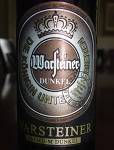 Brauerei of Arnsberger Forestpark, Germany. Dunkel, along with helles, is a traditional style brewed in Munich and popular throughout Bavaria. With alcohol concentrations of 4.5% to 6% by volume, dunkels are less strong than doppelbocks, another traditional dark Bavarian lager. Friends of Warsteiner are welcomed to tour the brewery at Waldpark and see for themselves the high technical standards throughout the production process. From quality control on arrival of the raw materials, to the brewing process in the brew-house, the fermentation cellar, and during bottling on highly advanced bottling lines. No tour is complete without a beer tasting in the cozy, rustic atmosphere of our Waldfrieden guest house, where guests can treat themselves to a freshly drawn Warsteiner served in a elegant glass mug, a present to visitors as a souvenir after an entertaining and instructive day devoted to beer
Brauerei of Arnsberger Forestpark, Germany. Dunkel, along with helles, is a traditional style brewed in Munich and popular throughout Bavaria. With alcohol concentrations of 4.5% to 6% by volume, dunkels are less strong than doppelbocks, another traditional dark Bavarian lager. Friends of Warsteiner are welcomed to tour the brewery at Waldpark and see for themselves the high technical standards throughout the production process. From quality control on arrival of the raw materials, to the brewing process in the brew-house, the fermentation cellar, and during bottling on highly advanced bottling lines. No tour is complete without a beer tasting in the cozy, rustic atmosphere of our Waldfrieden guest house, where guests can treat themselves to a freshly drawn Warsteiner served in a elegant glass mug, a present to visitors as a souvenir after an entertaining and instructive day devoted to beer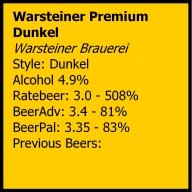
Warsteiner Premium Dunkel, "German for Dark" offers beer lovers incomparable taste satisfaction with its subtle spiciness, delicate aroma, and balance. What makes premium Dunkel distinctive among dark beers is its thirst quenching, refreshingly drinkable flavor. Warsteiner Premium Dunkel is a traditional German dark brown lager. In Germany, they would refer to this style of beer as, "Dunkel". Warsteiner Premium Dunkel is described as being neither sweet nor roastily dry, with a slight spicy maltiness and a clean round finish. It has a reddish-black color which is almost opaque.

The last beer of the night is the Paulaner Salvator, a Doppelbock. The name of the Paulaner brewery refers back order of monks of San Francesco di Paola, who resided in Neuhauser Straße in Munich. The monks had brewed beer for their own use since 1634. The beer that was permitted to be sold on holidays was a Bock style which gained local fame. Franz Xaver Zacherl, the brewer, purchased the former cloister brewery and continued the "Starkbier" tradition with the product Salvator, which is Latin for "Saviour". In 1861 the "Salvatorkeller" (Salvator cellar) was opened upon Nockherberg. In 1928 the brewery merged with the Gebrüder Thomas brewery creating Paulaner Salvator Thomas Bräu. 1994 saw the acquisition into the Kulmbacher brewery group with the affiliated producers Plauen and Chemnitz.
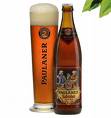 Paulaner Salvator was served by the monks as a replacement for food at Lent. Their most famous brewer was Brother Barnabas, who was the head of the Paulaner monastery brewery starting from 1773. Its original recipe is today almost the same as it was in Barnabas' time. In order to protect the original recipe, Paulaner had the trade mark "Salvator" patented in 1896.
Paulaner Salvator was served by the monks as a replacement for food at Lent. Their most famous brewer was Brother Barnabas, who was the head of the Paulaner monastery brewery starting from 1773. Its original recipe is today almost the same as it was in Barnabas' time. In order to protect the original recipe, Paulaner had the trade mark "Salvator" patented in 1896.
Comments:
<< Home
Truly when someone doesn't be aware of afterward its up to other visitors that they will assist, so here it takes place.
Here is my page ... dumpster rentals
Post a Comment
Here is my page ... dumpster rentals
<< Home
